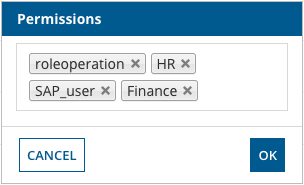| The capabilities described on this page are included in Appian's standard capability tier. Usage limits may apply. |
Credentials are a secure way to store usernames and passwords that robotic tasks might need to log in to external systems. You can use the Appian RPA console to store, reference, and update credentials.
All RPA credentials use AES 256-bit encryption, and follow the FIPS Security Model for Cryptographic Modules standard. When credentials are created or updated, they are securely encrypted and stored in a database. The encryption key used for credentials is unique not only to each environment, but also separate from the other keys that are used to encrypt other fields. Each key is stored securely in the Java KeyStore, the password for which is uniquely generated at site startup.
In the toolbar on the Robotic tasks tab, click the Credentials icon to manage credentials:

The List of credentials displays the credentials defined in the console, and allows you to perform different actions on them.

This list includes the following information:
[PROTECTED] to ensure security).To create credentials:

To update credentials:
[PROTECTED] to update the password for a credential entry.To delete credentials:
You can use low-code actions to add credentials to your robotic task. Use the Interact with Element method in a robotic task to input credentials in a web browser, or use the Type text method when the robotic task logs into an application. You can also use the Windows Automation module's Interact with Element method to input credentials into Windows applications.
Note: Never store usernames, passwords, or other sensitive information as plain text. If you use the task recorder to record login actions, remember to always remove the username and password values before saving the recording and update the generated actions to use credentials.
Access to credentials is controlled through permissions. A robotic task must have at least one permission in common with the credentials it needs to use.
To assign or modify permissions for credentials:
 in the Actions column.
in the Actions column.